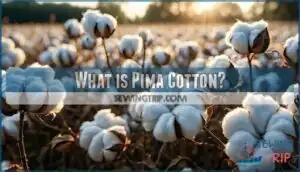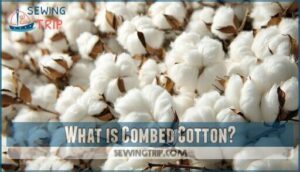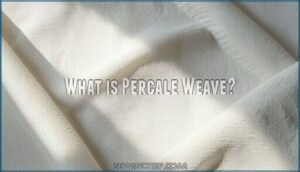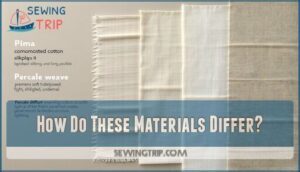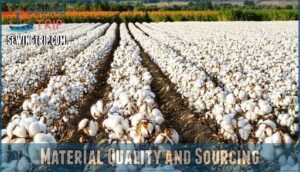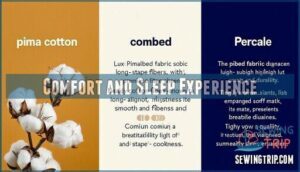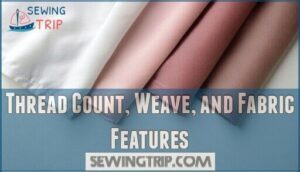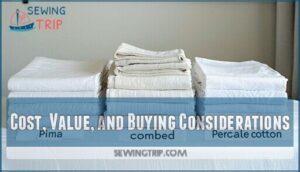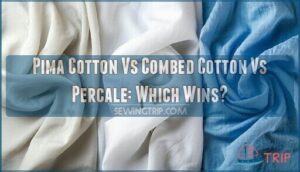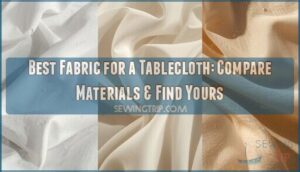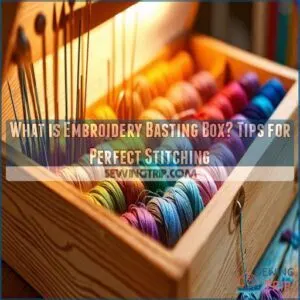This site is supported by our readers. We may earn a commission, at no cost to you, if you purchase through links.
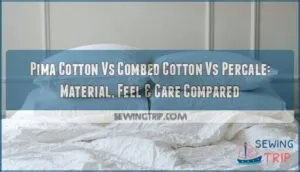 Slip your hand across soft sheets and you might not give their story a second thought—but look closer, and every thread is doing its job. Pima cotton drapes with a luxe weight, combed cotton feels impossibly smooth, and percale weave breathes easy on sticky nights.
Slip your hand across soft sheets and you might not give their story a second thought—but look closer, and every thread is doing its job. Pima cotton drapes with a luxe weight, combed cotton feels impossibly smooth, and percale weave breathes easy on sticky nights.
Choosing between them isn’t just about price tags or pretty labels; it’s a matter of comfort, care, and what you want from a good night’s sleep. Understanding how pima cotton, combed cotton, and percale stack up will help you pick what really suits your life—not just your linen closet.
Table Of Contents
- Key Takeaways
- Pima Cotton, Combed Cotton, and Percale Explained
- Material Quality and Sourcing
- Durability and Maintenance
- Comfort and Sleep Experience
- Thread Count, Weave, and Fabric Features
- Cost, Value, and Buying Considerations
- Pima Cotton Vs Combed Cotton Vs Percale: Which Wins?
- Frequently Asked Questions (FAQs)
- Conclusion
Key Takeaways
- Pima cotton delivers luxury softness and durability thanks to extra-long staple fibers, making it ideal for high-end bedding and sensitive skin, though it comes at a higher price point.
- Percale weave creates crisp, breathable sheets with a matte finish that excels at keeping hot sleepers cool, while offering excellent durability and easier care than silkier sateen options.
- Combed cotton strikes a practical middle ground by removing short fibers for improved softness and uniformity, providing quality comfort at more budget-friendly prices than Pima.
- Your best choice depends on personal priorities: Pima for plush luxury and longevity, percale for cooling breathability and crispness, or combed cotton for reliable everyday comfort without premium costs.
Pima Cotton, Combed Cotton, and Percale Explained
Choosing the right material comes down to more than just softness or price.
Let’s take a closer look at how Pima cotton, combed cotton, and percale each stand out. Here’s what makes each one unique as a fabric for your home.
What is Pima Cotton?
If you’ve ever wondered what sets the softest, longest-lasting cotton apart, Pima cotton is where the story really begins. Its extra-long staple fibers are the secret behind that signature softness and amazing durability. You’ll notice the benefits every night, especially with high-end sheets or towels.
- Great wrinkle resistance for easy care
- Luxury applications in bedding and clothing
- Grown in select regions for quality consistency
What is Combed Cotton?
While Pima cotton gets a lot of attention for its luxury feel, combed cotton earns its place with a softer touch that comes from a special extra step in the process.
The combing process gently removes short fibers and impurities, enhancing softness and aligning cotton fibers neatly.
This makes combed cotton fabric ideal for everyday textiles, clothing, and bedding material.
What is Percale Weave?
When you’re aiming for that crisp, cool feel in your sheets, percale weave is the secret ingredient that sets your bed apart. Percale uses a tight one-over-one-under cotton weave, making it breathable and smooth.
The Percale manufacturing process works with various thread types, offering fabric variations that balance softness, durability, and easy care. That’s the core of Percale weave benefits.
How Do These Materials Differ?
Now that you know what makes percale weave special, let’s look at how Pima cotton, combed cotton, and percale each bring their own flair to the fabric world.
Pima cotton shines for its long fiber length, boosting softness and absorbency levels. Combed cotton is all about production methods that improve comfort, while percale stands out for weave variations and cool material weight.
Material Quality and Sourcing
When you’re choosing cotton fabrics, where and how they’re made makes a big difference.
Let’s take a closer look at what sets each material apart. Here’s what you need to know about their origins and what goes into making them.
Origins and History of Pima Cotton
Ever wonder how a simple cotton plant journeyed across continents and became a luxury staple in bedrooms around the world? The story of Pima cotton is a patchwork of discovery and innovation:
- South American roots with Peruvian Pima cotton.
- Cross-pollination history, blending Egyptian and local varieties.
- Pima tribe collaboration.
- U.S. development and weaving.
- Extralong staple cotton delivers lasting properties.
Production of Combed Cotton
Before a cotton sheet can feel smooth in your hands, it has to go through a careful combing process that removes the rough edges and leaves only the softest fibers behind. This extra step in fiber preparation separates high-quality cotton from the rest. During yarn spinning, each strand is checked for consistency. Here’s how combed cotton production stands out:
| Step | Key Benefit |
|---|---|
| Fiber Preparation | Removes impurities |
| Combing Process | Enhances softness |
| Yarn Spinning | Boosts durability |
| Quality Control | Ensures uniformity |
Percale Weave in The Textile Industry
Across busy weaving rooms and quiet home studios alike, percale has earned its reputation as the go-to fabric for anyone craving crisp, cool sheets and reliable comfort.
Percale’s tight weave has sparked sustainability conversations and pushed weave innovation. In today’s textile industry, you’ll spot percale driving market trends thanks to its:
- Distinct smoothness
- Adaptable applications
- Timeless aesthetic
- Bright future outlook
Ethical and Environmental Considerations
Looking to choose bedding with a clear conscience? Sustainable sourcing and worker safety aren’t just marketing claims—they’re real markers of responsible textiles. From Pima’s USDA origins to GOTS-certified combed cotton, you’ll find huge differences in water usage, carbon footprint, and ethical traceability.
The environmental impact of cotton production varies, with fertilizer production a key contributor to emissions. Textile circularity and organic cotton options prove you can care for comfort and the planet at once.
Durability and Maintenance
How long your sheets last depends on what they’re made of and how you care for them. Some fabrics withstand daily wear better than others, and a few need more attention to stay at their best.
Here’s what you can expect from each option.
Lifespan and Wear Resistance
When you invest in sheets or clothes, you want something that stands up to daily life—and that’s where the true test of material durability begins. Compared side by side, here’s how Pima cotton, combed cotton, and percale measure up for long-term value:
- Material degradation varies by fiber strength
- Pima cotton resists wear
- Percale’s abrasion resistance holds up
- Combed cotton depends on processing quality
- Washing effects impact lifespan
Each option offers unique durability for everyday use.
Resistance to Wrinkles and Pilling
Nobody wants sheets that wrinkle like a forgotten shirt or pill up after just a few washes—so let’s see how these fabrics really hold their shape.
Pima cotton stands tall against both wrinkles and pilling, thanks to its strong fiber strength and clever weave density. Percale’s crisp weave boosts wrinkle reduction, while combed cotton’s finish offers moderate pilling resistance.
| Fabric | Wrinkle Resistance / Pilling Resistance |
|---|---|
| Pima Cotton | High / High |
| Percale | Moderate / High |
| Combed Cotton | Moderate / Moderate |
Care Tips for Each Material
Even the toughest fabrics need a little TLC to keep them looking and feeling their best. For Pima cotton, gentle washing techniques and low-heat drying methods extend softness.
Percale thrives with simple maintenance: avoid over-drying, use cool water, and fold promptly. Spot stains quickly, store cotton sheets in a dry spot, and follow ironing guidelines to preserve crispness and overall fabric care.
Chemical Finishes and Their Effects
Once you’ve got the basics down for daily care, it’s worth knowing how chemical finishes—like wrinkle-resistance or stain-repellents—can change the way your favorite sheets feel and last.
Some finishes in sheets, like those used on Pima cotton or Percale, may release formaldehyde, raising allergen concerns, while eco-friendly finishes and stricter chemical regulations are improving material quality and finish toxicity.
Comfort and Sleep Experience
Comfort makes all the difference for a good night’s sleep. Let’s look at what sets Pima cotton, combed cotton, and percale apart when you’re choosing bedding.
Here’s how each one stacks up for softness, breathability, and more.
Softness and Texture Comparison
Ever wonder what makes sliding into some sheets feel buttery-smooth, while others have a crisp snap under your hands? Pima cotton stands out for softness, thanks to its extra-long fiber length, resulting in excellent surface smoothness.
Percale’s tight weave gives you a cool, tactile sensation—think freshly laundered cotton with a subtle texture. Weave impact shapes sensory perception and overall comfort.
Breathability and Temperature Regulation
If you sleep warm or live somewhere humid, breathability matters. Pima cotton offers impressive moisture retention and air circulation, so you won’t wake up sweaty. Percale’s crisp weave helps sweat evaporate quickly, boosting year-round temperature regulation.
Cotton in general provides balanced thermal conductivity, but percale and Pima shine when you want a cool, consistently comfortable sleep environment—even in clinical settings. The fabric’s extra-long staple fibres contribute to its surpassing softness.
Best Uses for Each Material (Bedding, Clothing, Baby Clothes)
Choosing the right cotton type often comes down to how and where you plan to use it, whether that’s layering your bed for comfort, sewing cozy clothes, or finding something gentle for your baby’s skin.
- Pima cotton shines for high-quality bedding and cotton baby clothes—pure softness.
- Percale’s crisp weave is great for cool, breathable bedding.
- Combed cotton makes adaptable, budget-friendly clothing fabric options.
- Each one fits different needs, lending flexibility to your Bedding Material Choice or Baby Clothes Selection.
Suitability for Different Climates
Depending on whether your nights feel muggy or brisk, the kind of cotton you pick can make a big difference in how comfortable you feel year-round. If you need cooling features for hot, sticky weather, warm weather percale is a champion. For cool or cold winter nights, cold weather Pima locks in warmth and coziness, making your climate-specific bedding choice easy.
| Material | Best Climate | Breathability/Comfort |
|---|---|---|
| Pima Cotton | Cool, Cold | Insulating, soft, traps warmth |
| Combed Cotton | Mild, Humid | Adaptable, moderate airflow |
| Percale | Warm, Humid | Crisp, cooling, supreme breathability |
Thread Count, Weave, and Fabric Features
If you’ve ever been confused about what makes one sheet feel different from another, you’re not alone. Thread count, weave style, and the kind of cotton play a big part in how your bedding looks and feels.
Here’s what you’ll want to know before you pick your next set.
How Thread Count Affects Quality
Think thread count is just a numbers game? There’s a bit more to the story regarding how it shapes the feel and quality of your sheets.
Thread count myths linger, making “higher count better” sound true, but there are limits. Top-quality Pima cotton or percale leans on careful weaving—quality beyond count matters more than numbers alone.
Percale Vs. Sateen Vs. Other Weaves
Wondering how cotton weave changes your sleep? Percale weave stands out for its crisp, matte finish, durability, and coolness, making it ideal for summer.
Sateen, by contrast, feels silkier but can trap heat. Each cotton weave offers unique texture differences and seasonal use.
Cost comparison? Percale is generally more affordable, while Sateen’s sheen nudges prices higher.
Extra-Long Staple Cotton Benefits
When you see “extra-long staple cotton” on a label, you’re looking at the secret behind sheets and shirts that stay smooth and soft, wash after wash. Longer fibers—think Pima cotton—mean you get:
- Fewer pills and snags (Durability Advantages)
- Noticeably enhanced softness
- High absorbency qualities for comfort
- Lasting color retention
- The luxury applications you want
Color, Pattern, and Aesthetic Choices
After savoring the feel of extra-long staple cotton, it’s only natural to want sheets that look as good as they feel, and that’s where color, pattern, and style really step in.
The choice of material and weave pattern shapes color palette and visual texture, while color fastness and pattern durability reveal how bedding stands up to aesthetic trends, dye impact, and everyday use.
Cost, Value, and Buying Considerations
When choosing cotton sheets, price and value matter just as much as comfort.
Let’s take a look at what really influences cost and how to spot the best deals.
Here’s what you should know before making your pick.
Price Differences and What Influences Cost
While Pima cotton commands a higher price thanks to its extra-long staple length and prized material quality, combed cotton gets a boost from extra processing costs.
Percale’s affordability often depends on thread count and weaving method, but supply chain swings, brand premiums, and occasional retail discounts can tip the scales.
Ultimately, what you pay reflects quality and careful sourcing.
Value for Money: Durability Vs. Price
Sure, the initial investment for Pima cotton or high-quality Percale might be steeper, but here’s where long-term savings show up: greater durability means fewer replacements, so your cost per use drops each year.
That slower replacement frequency isn’t just good for your wallet—it lightens your environmental impact, too. Cotton quality truly shapes both price and value.
Brand Recommendations and Reviews
If you’re looking for sheets that truly match up to their reputation and your investment, let’s talk about some real-world brands and what people say after sleeping on them night after night.
- Top Pima Brands earn praise for silkiness and resilience—worth the splurge.
- Percale Sheet Reviews highlight crisp comfort, even among Budget-Friendly Options.
- Ethical Brand Choices and Combed Cotton Leaders impress with durability and fair practices.
Choosing The Right Sheets for Your Needs
What matters most as you size up your next set of sheets—softness, breathability, or maybe that cool, crisp feel every time you climb into bed?
Your sleep preferences, lifestyle factors, and even the season play a role in choosing the perfect sheets.
Weigh Pima cotton for luxury, Percale sheets for cool sleep, and balance fabric choices with budget considerations for comfort year-round.
Pima Cotton Vs Combed Cotton Vs Percale: Which Wins?
Choosing between Pima cotton, combed cotton, and percale can feel overwhelming if you’re not sure what matters most to you.
Each has its own strengths and trade-offs, especially regarding comfort, durability, and cost. Here’s a quick look at how they stack up side by side.
Pros and Cons of Each Option
Choosing between these standout fabrics is a bit like picking your favorite dessert—they each have their own strengths, but the best fit depends on what you’re craving most in comfort and care.
Here’s a quick comparison of cotton materials:
| Fabric | Key Pros |
|---|---|
| Pima Cotton | Luxurious, long-term value, gentle on skin |
| Percale | Cool, crisp feel, fewer health concerns |
| Combed Cotton | Affordable, broad user preferences, lower impact |
Which is Best for Bedding?
No matter how you like to curl up at night, the kind of cotton on your bed can make all the difference in how cozy you actually feel. If you’re after ultra-smooth luxury and long-term satisfaction, Pima cotton leads. Percale, meanwhile, feels lighter and crisp—great if you sleep hot or want year-round comfort. Take a look:
| Sheet Material | Key Bedding Perks |
|---|---|
| Pima Cotton | Plush, smooth, stays soft |
| Percale | Cool, crisp, breathes well |
| Combed Cotton | Basic, budget-friendly |
| Warmth/Weight | Pima is warm, Percale airy |
| Best for | Personal preferences, budget |
Which is Best for Clothing?
Slide into your favorite tee and you’ll quickly realize—what’s next to your skin can change how you feel all day long. Regarding clothing, Pima cotton wins for sensitive skin and all-day comfort. Combed cotton is practical and soft enough for most, while Percale, though smooth, isn’t as common in clothing.
| Fabric | Best Seasons | Activity Level |
|---|---|---|
| Pima Cotton | Year-round | High, sensitive skin |
| Combed Cotton | Spring/Fall | Moderate |
| Percale | Summer | Low, casual |
Frequently Asked Questions (FAQs)
What is the difference between pima cotton and combed cotton?
Long-staple cotton like Pima is prized for naturally long fibers—think strength and softness all-in-one.
Combed cotton describes the process: fibers are refined for smoothness, but not all are long-staple.
Best uses vary with durability and feel.
What is the difference between percale and sateen?
Percale weave gives sheets a crisp, matte finish, ideal for hot sleepers and easy ironing needs.
Sateen sheets, with their silky drape, higher sheen level, and warmer feel, suit cooler climates.
That’s the quick Percale vs Sateen Weave snapshot.
Which type of cotton is better for hot sleepers?
Hot sleepers often find the crisp, breathable fabric of percale sheets hard to beat.
Their cooling properties, ideal weave, and excellent moisture wicking deliver standout comfort for hot-sleeper needs—making percale the top choice for breathability comparison.
Which type of cotton is better for cold sleepers?
For chilly nights, denser, warmer sheet options work best. Cotton warmth factors like insulation properties and fiber density matter most.
Pima Cotton Sheets usually offer better warmth and softer layering possibilities than standard percale sheets, meeting cold sleeper needs.
What is the best way to care for cotton sheets?
Isn’t it funny how we fuss over “luxury” sheets, then wash them like old t-shirts?
For durable sheets, use gentle detergent, wash weekly, line dry or low-heat tumble, tackle stains quickly, and store in a cool, dry place.
Are any of these fabrics hypoallergenic or allergy-friendly?
Natural fibers like Pima cotton sheets and percale sheets are often considered hypoallergenic, especially when free from chemical finishes. Their tighter weave density helps block fabric allergens, making them a safe pick for those with chemical sensitivities.
How do these fabrics impact sensitive skin?
Forget scratchy sheets masquerading as “luxury.” For sensitive skin, natural fibers like Pima Cotton Sheets and Percale sheets usually feel gentler.
Hypoallergenic, low-irritation finishes, and soft weaving keep allergy considerations and chemical sensitivities to a minimum—true fabric skin sensitivity care.
Can you iron or steam these materials safely?
You can iron Pima and combed cotton at medium temperatures, but use low heat for Steaming Percale due to its weave pattern.
Proper sheet care and maintenance guarantees durability—watch for heat damage and respect each fabric’s sensitivity.
Do these fabrics shrink or fade after washing?
Cotton fabrics can shrink or fade if you skip the right washing techniques. Cool water, gentle cycles, and low heat for drying help preserve color retention and durability.
Proper sheet care and maintenance prevent pilling, shrinkage, and fading.
Are any of these fabrics prone to static cling?
Catch yourself wrestling with a shirt or sheet that clings? Static electricity buildup is rarely an issue in cotton fabrics.
Humidity level effects, fabric composition impact, and a consistent washing routine influence static—anti-static product use is rarely necessary.
Conclusion
Picking between pima cotton vs combed cotton vs percale isn’t about picking a winner—it’s about matching material to moment. Soft, silky pima suits sleepers who crave luxury; combed cotton delivers smooth reliability without the splurge; crisp percale breathes life into warm nights.
Your sheets should work as hard as you do, wrapping you in comfort that fits your lifestyle, not just your bed. Choose wisely, sleep soundly, and let every thread earn its place.

